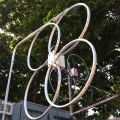Timestamp on S-Meter [extension]
This may have been discussed before but I couldn't find it on a quick search.
The S-Meter extension is great for spotting trends in QRM but where the speed is slow and timescale wide, it is hard to work out when a change or event happened. E.G. I have a noise source I don't really recognise on 40m, I want to leave the S-Meter running and look for changes around people arriving home or "on the hour" etc.
Would it be possible to have a timestamp (hint) on the scale?
Dot at UTC points would be enough, large on the hour, small at X min etc.
Or an option on the Marker Rate as "UTC hour". "UTC 30min" so that the markers line up with hour, half hour etc.
If anyone has a good way to do it already I'm happy to hear.
I could screen capture the display with clock at set intervals I suppose....
Stu
The S-Meter extension is great for spotting trends in QRM but where the speed is slow and timescale wide, it is hard to work out when a change or event happened. E.G. I have a noise source I don't really recognise on 40m, I want to leave the S-Meter running and look for changes around people arriving home or "on the hour" etc.
Would it be possible to have a timestamp (hint) on the scale?
Dot at UTC points would be enough, large on the hour, small at X min etc.
Or an option on the Marker Rate as "UTC hour". "UTC 30min" so that the markers line up with hour, half hour etc.
If anyone has a good way to do it already I'm happy to hear.
I could screen capture the display with clock at set intervals I suppose....
Stu

Comments
I totally agree with it's superb features but some things it misses.
I have some intermittent drifting switcher type noises that I want to track down.
It might be the small battery/solar lamp about three feet from my antennas, probably should just take the battery out and see if it goes away.
Could do with a way to log sunshine against the noise too, tiny VCO controlled by solar panel voltage on a t-piece maybe.
You could do a simple mod to excecute a script on schedule. It already knows about sunrise/sunset so you could doing something based on time . Or, you could mod it to run a script on every cycle and check for sunshine and act.
By the time one looks at higher harmonics, which may still be relatively low HF, the spectral width is such that these lines overlap and tend to hide their nature and SMPS source. Sometimes this can be heard in wideband AM as well as seen in analysis. There can be a telltale growl as contrasted to the nice 'pop' and 'crackle' of propagated noise.
Combining self-correlation of this sort of noise along with absolute S-meter levels can be very helpful in identifying and better understanding both their presence, location and techniques to mitigate their couplings into Kiwis.